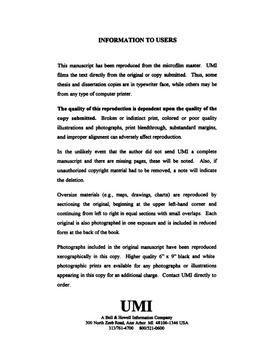| dc.contributor.advisor | Wheeler, Ralph A., | en_US |
| dc.contributor.author | Grafton, Anthony Kurt. | en_US |
| dc.date.accessioned | 2013-08-16T12:30:17Z | |
| dc.date.available | 2013-08-16T12:30:17Z | |
| dc.date.issued | 1998 | en_US |
| dc.identifier.uri | https://hdl.handle.net/11244/5697 | |
| dc.description.abstract | The functions of the quinones present in both plant and bacterial photosynthetic reaction centers is still not completely understood. Presented here is a detailed computational study of a variety of properties of various quinone species important to photosynthetic processes. It is first demonstrated that the hybrid Hartree-Fock/density functional method Becke3LYP (B3LYP) can accurately predict the structure of many neutral, reduced, and protonated methyl-substituted 1,4-benzoquinones and 1,4-naphthoquinones. It is shown that qualitative spin densities and accurate isotropic hyperfine coupling constants may also be calculated for quinone radical anions, although the heavy atom hyperfine coupling constants show some basis set dependence. The B3LYP method is also demonstrated to reproduce the ordering of experimentally determined vibrational frequencies of quinones and a variety of their reduced and protonated forms in nearly all instances. Qualitative shifts in vibrational frequencies upon protonation or hydrogen bonding are predicted and discussed relative to experiment. The vibrational projection analysis method is developed to compare vibrational normal modes and presented as a simple but powerful technique that should be applicable to a wide range of systems. Next, it is shown that the B3LYP method can be used to predict adiabatic electron affinities for a variety of quinones to within 0.05 eV of experimental values. When this ability is combined with molecular dynamics free energy perturbation methods, accurate quinone aqueous one-electron reduction potentials may be obtained. This method generally reproduces reduction potentials to within 0.20 eV of experiment, although exceptional accuracy (within 0.05 eV) was obtained for ubiquinone and plastoquinone. Lastly, molecular dynamics simulations of ubiquinone binding in the photosynthetic reaction center of Rhodobacter sphaeroides are presented which support the theory that the neutral and radical anion Q$\rm \sb B$ quinones bind in different locations. The differences in binding are attributed to differing protonation states of the nearby amino acids GLU L212 and ASP L213. It is suggested that the movement of the quinone between sites may depend on the protonation state of L213 particularly, and that L212 is likely to be predominantly protonated in all cases. | en_US |
| dc.format.extent | xiv, 210 leaves : | en_US |
| dc.subject | Biology, Plant Physiology. | en_US |
| dc.subject | Photosynthesis. | en_US |
| dc.subject | Density functionals. | en_US |
| dc.subject | Molecular dynamics. | en_US |
| dc.subject | Chemistry, Physical. | en_US |
| dc.subject | Vibrational spectra. | en_US |
| dc.subject | Quinone. | en_US |
| dc.title | A computational study of the structural, spectroscopic, thermochemical and binding properties of quinones involved in photosynthesis. | en_US |
| dc.type | Thesis | en_US |
| dc.thesis.degree | Ph.D. | en_US |
| dc.thesis.degreeDiscipline | Department of Chemistry and Biochemistry | en_US |
| dc.note | Source: Dissertation Abstracts International, Volume: 59-09, Section: B, page: 4833. | en_US |
| dc.note | Major Professor: Ralph A. Wheeler. | en_US |
| ou.identifier | (UMI)AAI9905613 | en_US |
| ou.group | College of Arts and Sciences::Department of Chemistry and Biochemistry | |
